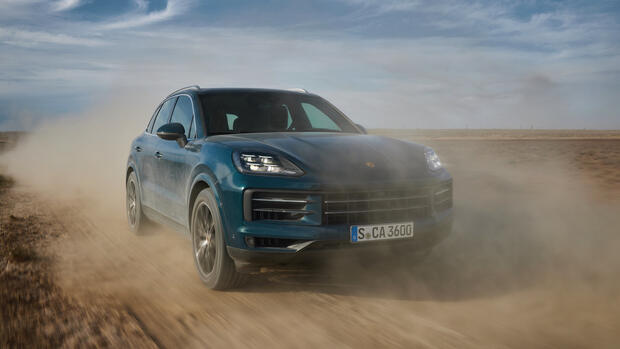Stuttgart The Cayenne accounts for more than 30 percent of Porsche sales every year. This means: He is an extremely important model that wants to be treated with care. The facelift of the third generation, which started in 2017, was correspondingly extensive. The year 2030 also shows that the Swabians are not orienting their model cycles to the often rather short-lived product policy of their Asian competitors in particular: Until then, the combustion and hybrid Cayenne should support the balance sheets of the sports car manufacturer – from 2025 in parallel with the electric version . This period is easily enough for a complete generation of cars for somewhat more popular brands.
What can be seen from the outside of the great effort involved in the facelift? If you take a closer look, you will see the newly designed front end, the slightly more powerfully shaped fenders and the slightly crisper bonnet. The most striking are undoubtedly the headlights in the current Porsche look. Matrix LED technology is now standard. And on request there are also HD matrix main headlights.
They actually turn night into day, we’ve already tried it out in the far north. No wonder given the 32,000 pixels per side, which can hide oncoming traffic, pedestrians or even a moose with pinpoint accuracy. The side line of the Cayenne has remained largely untouched, the rear with smoother surfaces and the number plate holder that has slipped down looks tidier than before. There are also three new colors, a lightweight package for the coupé that saves 33 kilos and various wheels from 20 to 22 inches.
The interior is very similar to that of the Taycan with a curved display and an optional additional screen for the co-pilot. A new feature in the Cayenne is an air quality system that switches to air recirculation before entering a tunnel. A sensor analyzes the air quality in the interior and, if necessary, triggers a multiple flow through the fine dust filter, an ionizer clears germs and other pollutants out of the way.
The security guard armada has been revised and expanded, including the active speed limit assistant, the avoidance and turning assistant and the improved adaptive cruise control.
The Cayenne E-Hybrid, here as a coupé, can cover up to 90 kilometers purely electrically
(Photo: Porsche)
If desired, the front passenger can now also operate their own display
(Photo: Porsche)
Two (Cayenne) and four externally mounted exhaust tailpipes (Cayenne S and E-Hybrid) are standard for the engines available from the start – unless the sports exhaust system with two central tailpipes was ordered. However, this disqualifies the Cayenne as a towing vehicle because it cannot be used to mount a trailer hitch.
The basic model of the series is the slightly stronger Cayenne, now with 260 kW/353 hp and 500 Nm. The E-Hybrid is also based on its six-cylinder, which has significantly increased in terms of output (346 kW/470 hp), battery capacity (25.9 kWh) and all-electric range (up to 90 kilometers). He now comes with an 11 kW on-board charger, which should enable a full charge in less than two and a half hours. The top-of-the-range model is the Cayenne S, with which Porsche is fulfilling a heartfelt wish for fans of as many cylinders as possible. The in-house V8 with a displacement of four liters replaces the previous six-cylinder. And with 349 KW/474 hp and a torque of 600 Nm, it clearly outshines its predecessor.
The rear looks clearer, the license plate has slipped down
(Photo: Porsche)
The 485 kW/659 hp Cayenne Turbo GT is not offered in Europe
(Photo: Porsche)
The Cayenne Turbo GT is not available in Europe because of the strict emission limits. Its V8 biturbo has been boosted by 14 kW/19 hp to 485 kW/659 hp, it accelerates from zero to 100 km/h in 3.3 seconds and reaches a top speed of 305 km/h. The chassis of the large all-wheel drive vehicle, which was definitely not objectionable to date, has also been revised down to the last detail. The goal: a greater spread between comfort and long-distance capabilities, cornering performance and scrambling properties. This is ensured, for example, by the standard steel spring chassis with Porsche Active Suspension Management (PASM) plus new shock absorbers with 2-valve technology and separate rebound and compression stages.
As an option, the Zuffenhauser offer an adaptive air suspension with two-chamber two-valve technology. This should further increase driving precision and reduce body movements at high speeds. The new Cayenne can be ordered now. A look at the price list shows an increase of a good 6,000 euros for the basic model, which is no longer available for less than 89,100 euros, the coupé costs from 93,150 euros. For the E-Hybrid, Porsche charges from 103,350 euros (Coupé from 106,350 euros), for the Cayenne S from 107,550 euros (Coupé from 112,800 euros).
More: This is how Mercedes makes Maybach electric
